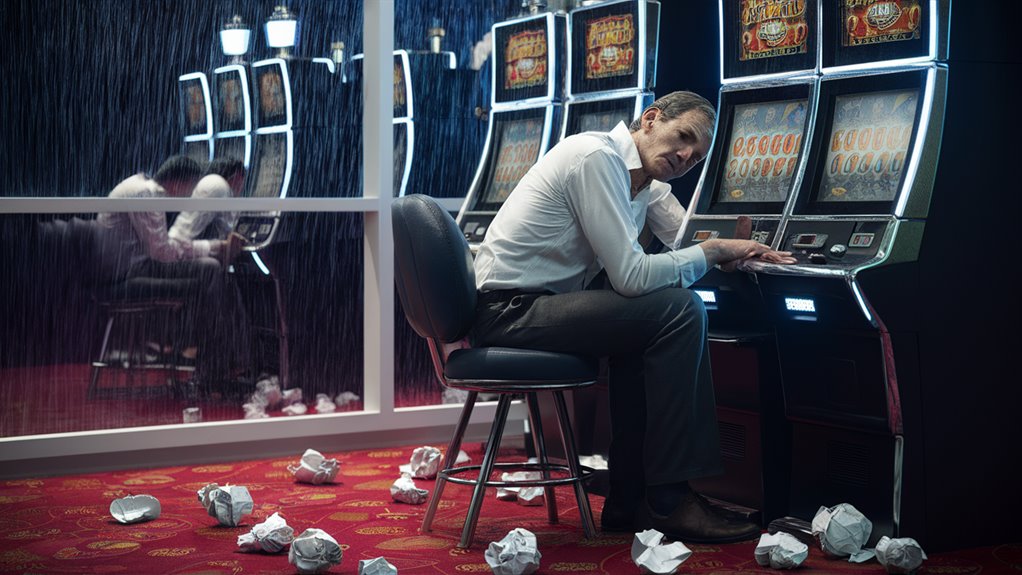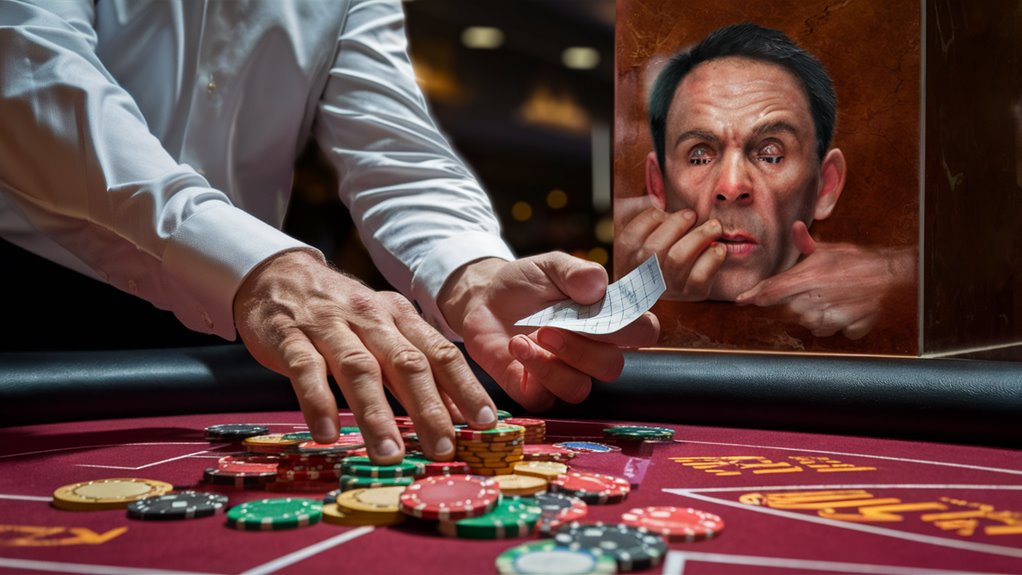How to Break Free from Loss Chasing: Understanding the Psychology

The Big Hit of Loss
Fearing loss leads to a strong mind reaction that can push aside smart choice-making. Studies show money lost hits us twice as hard as money gained, working in ways like real pain does. This big feeling change messes up how we make choices.
The Brain Loop of Chasing Losses
When we face losses, the brain starts a risky loop: stress-building bits take over choice-making parts while the happy-circuit breaks down. This leads to:
- low skills in risk checks
- less smart thoughts
- bigger feeling highs
- more chances taken
How to Stop Chasing Losses
Important Safety Actions
Set ups that help block quick choices. Needed safety steps include:
- Must-take break times
- Day-long trading limits
- Set money loss stops
- Automatic stop rules for trades
Ways to Fix the Mind
Proven methods help fight the need to chase losses by:
- Changing mind paths
- Reducing stress through being aware
- Spot the patterns
- Basic Guide
- Altering behaviors
This mix of good controls and smart mind paths helps end bad loss-chasing and builds smarter choice paths.
Understanding the Mind of Loss Chasing
The Mind Behind Loss-Chasing Actions
Why the Brain Chases Losses
Our brains show a big mind reaction to losses, making us want to get back what’s gone.
Not liking losses drives us to feel them double compared to when we gain. This gets us really set on getting back what we lost.
What Drives Us to Keep Chasing
The Sunk Cost Trap
The idea of sunk cost is big in holding on to the chase. This mind trap makes us put in more since we already put in a lot, not really seeing what’s coming.
Sticking to past spends stops smart choices.
How We See Ourselves and Our Choices
When losing, we face mental fights between how we see us and what’s real. This makes us take bigger risks to show our first choices were right, and keeps our self-view as good choosers.
The Brain’s Reward Part
Happy signals can break during loss chasing, making moves like bad habits. This brain change turns the hunt for losses into a need more than a choice.
Taking More Risks
When facing losses, our brain’s panic button turns on, leading to:
- High risk okay
- Choices getting worse
- Less thought on what may happen
- Going all in to get back losses
This cycle might lead to more money lost as choices get riskier.
What Makes Us Choose Risks
Ways Emotions Drive Risky Money Choices
The Mind in Money Choices
Emotional pulls shape big-risk money moves, mixing feelings and how we use money.
Studies show feeling bits like shame, sadness, and worry push us towards more risks to get back losses. These feelings skip over smart thinking, spotted as “hot state choices.”
Key Feelings in Money Acts
Fear of missing out and seeing others make strong moves in how we decide. Seeing others do well often pushes us to compete, hurting our clear thinking. Brain studies show money lost lights up the same parts as real pain, telling why we hate losing cash and rush to get it back.
Stress and Checking Risks
Big pressure spots change how we go after losses.
Looking at trading shows the riskiest choices happen when emotions are high. Stress lifting changes how we check dangers, making it key to have safety actions like:
- Must-take break times
- Plan for checking risks
- Knowing feelings better
- Clever choice ways
These help us keep smart minds when making big money moves, leading to better outcomes.
Ending the Loss-Chasing Round
How to Stop the Loss Chasing: Full Guide

Getting the Loss-Chasing Mind
Loss-chasing acts are a bad loop in betting and trading where folks try to fix losses with more risks.
To break free, we need seeing patterns, smart steps, and changing acts.
Seeing the Warning Bits
Key shows of loss-chasing patterns include:
- Bigger bets than okay
- Long hours trading or gaming
- Big worry
- Ignoring set rules
- Pulling back from usual stuff
Setting Strong Stops
Money Stops
- Make hard loss limits for days, weeks, months
- Top bets set
- Make auto stop-loss orders
Time-based Checks
- Pick trading times
- Plan must-take breaks
- Set cool-down times
Proven Ways to Cope
Right Now Fixes
- Try being aware when quiet
- Use new thought paths
- Handle stress plans
- Make a 24-hour wait rule
Long-run Fix Plan
- Get a helping circle of known helpers
- Find other ways to cool down stress
- Make a team to check on you
- Keep a deep recovery log
Adding Expert Help
Meet with expert helpers who know about bad habits
Join help groups
Use money advice
Get quick help tools
Seeing Red Signs
Warnings and Danger Signs of Loss-Chasing
How We Act Badly
Loss-chasing ways show in key signs in trading and gaming.
Growing bets post-losses are a big red flag, often with risky moves like using savings or loans to keep going.
Can’t stop trading occurs when folks rise risks to fix past losses.
Deep Feelings and the Mind Signs
Big feeling hits after money losses are key warnings. These include:
- Sharp worry about trade ends
- Staying mad post-losses
- Strong need to fix lost money
Folks in a loss chase often stick to old bad moves and build more twisty fix plans.
Touching Life and Self
Changes in how one acts reach past just money moves:
- Pulling away from family and pals
- Hiding how you trade
- 먹튀검증 순위
- Hiding money talks
- Not doing job tasks well
High Danger Ways
Big warning bits include:
- Quick moves post-losses
- Sleep less
- Drink more
- Can’t stop checking trading sites
- Quick money moves
Watch for excusing big risks as needed steps for getting back losses, showing deeper issues.
Often checking sites and can’t stop trading point to rising loss-chasing ways.
Making Better Money Moves
# Making Better Money Moves
Breaking the Loss-Chasing Loop
Money fix starts with strong cash rules and smart choice paths.
Setting a planned money plan sets clear lines, giving set amounts for putting money in, keeping money, and fun spends, really helping against mood-driven money moves.
Smart Choices Set Up
A must cool-off time is a key block before big money moves.
Having a day-long wait rule lets feelings cool and lets smart thinking lead.
Data backing up these smart delays cuts down quick money moves.
Money Choices on Auto
Set money controls build bases for keeping building money.
Automatic money moves and set times for putting money in work apart from mood swings, making sure money keeps growing.
Keeping a full money tracking book helps see patterns.
Tests show mixing watch-yourself paths with plans made before and hard loss stops can cut loss-chasing moves by almost 60%.
Must-Have Money Shields
- Automatic savings plans
- Money put-in schedules
- Tracking how you act
- Frameworks for loss limits
- Delays in decisions
Last Thoughts
The Mind of Chasing Losses: Freeing From Bad Trading Ways
Getting loss-chasing behavior in trading and money moves means seeing the deep mind bits driving our choices. This bad loop comes from deep-set mind traps and feeling pulls that can hit even the sharpest traders.
Getting the Mind Behind Loss Chasing
Hating Loss and the sunk cost idea push us hard to chase losses. When facing growing losses, our brains switch to living mode that can push aside smart choices, making us take on more risks to get back money gone.
Breaking the Loop with Data-Backed Strategies
Setting risk-check tools and making strong trading moves are key to stop loss hunts. Successful traders use:
- How much to put in plans
- Stop-loss actions
- Trading logs
- Risk-gain math
Building a Long-Run Solid Money Self
Bouncing back from loss-chasing needs a full-on approach with lasting trading ways. Pro help, with proven risk steps, builds a base for deep change and better money ends.
Building Safe Trading Moves
Making safe trading steps means putting in data-led choice ways. This covers setting clear risk rules, keeping calm in feelings, and sticking to set trading plans no matter the market moves.
